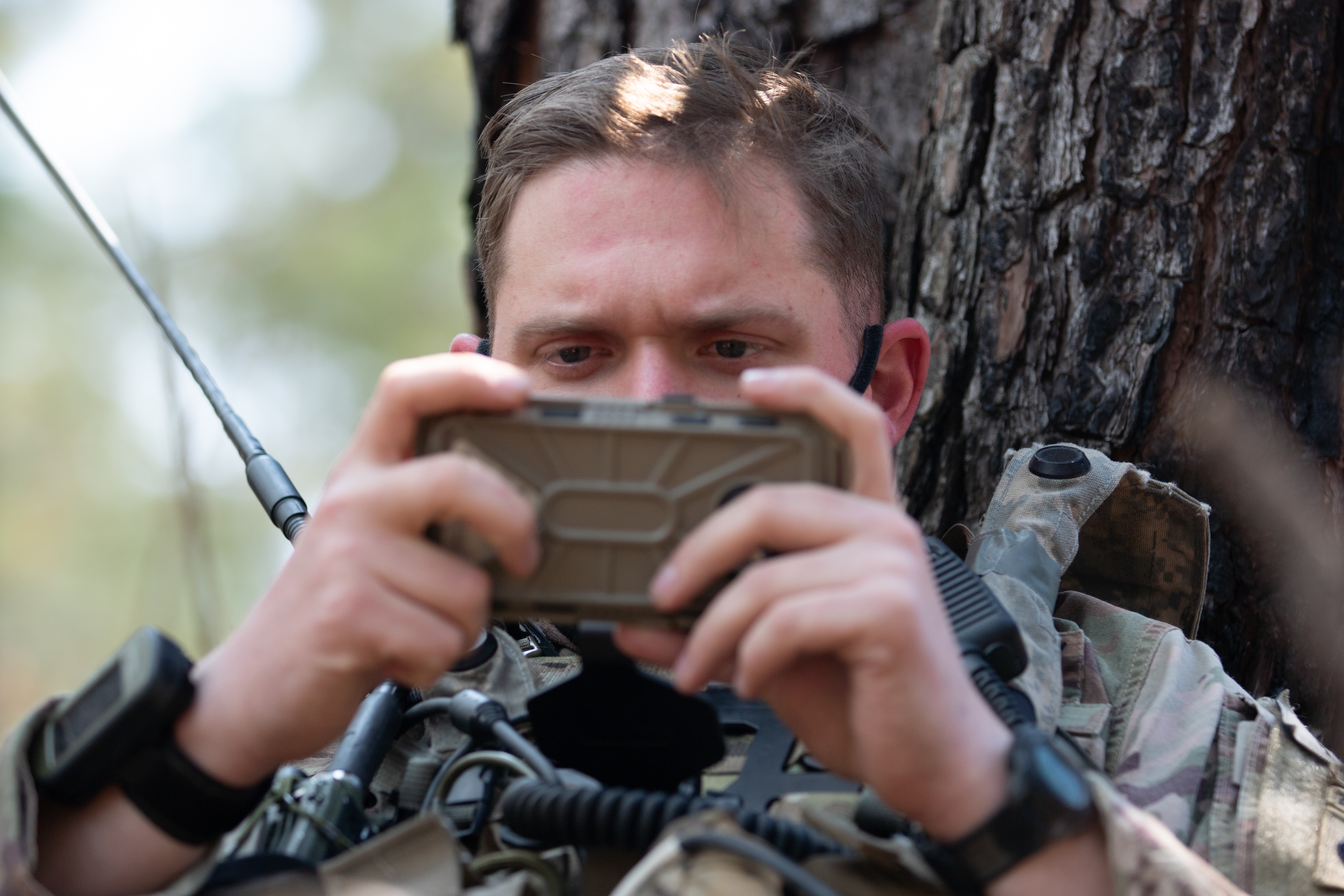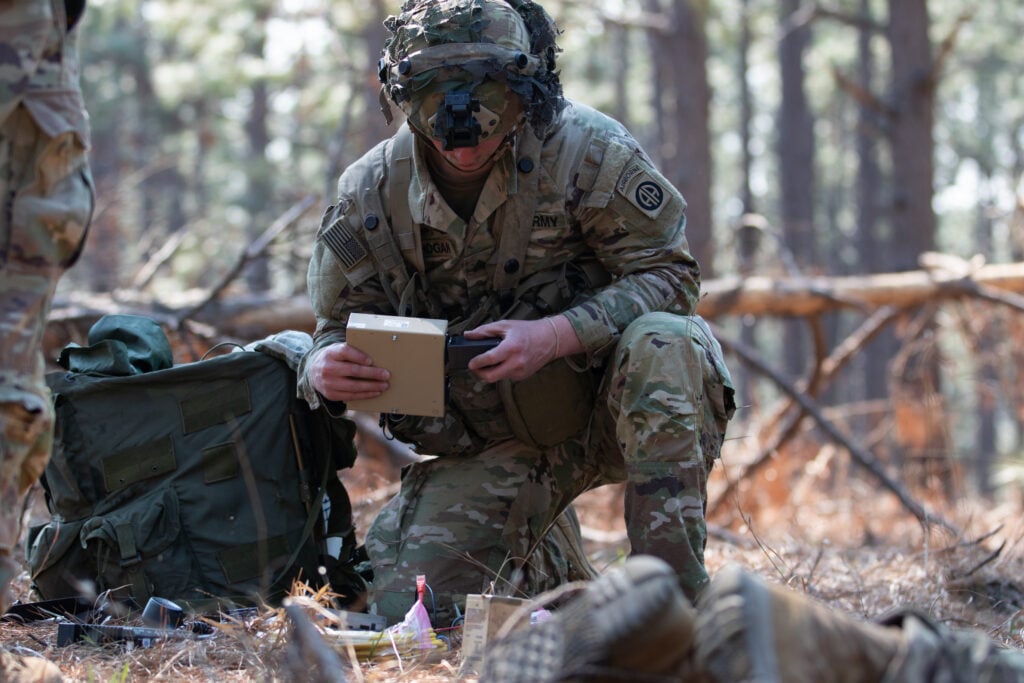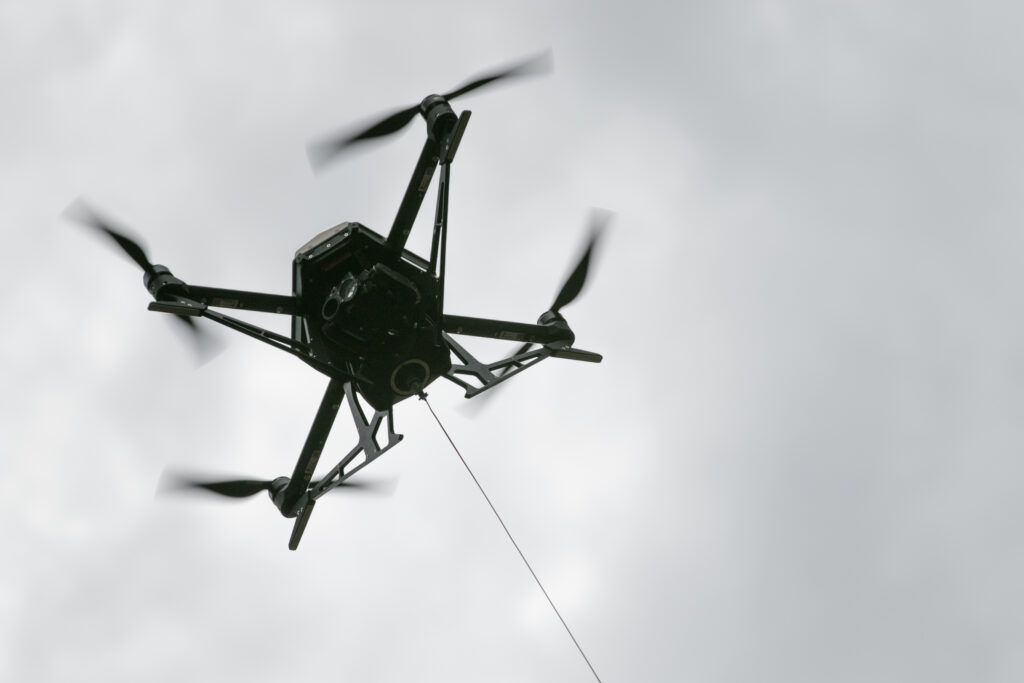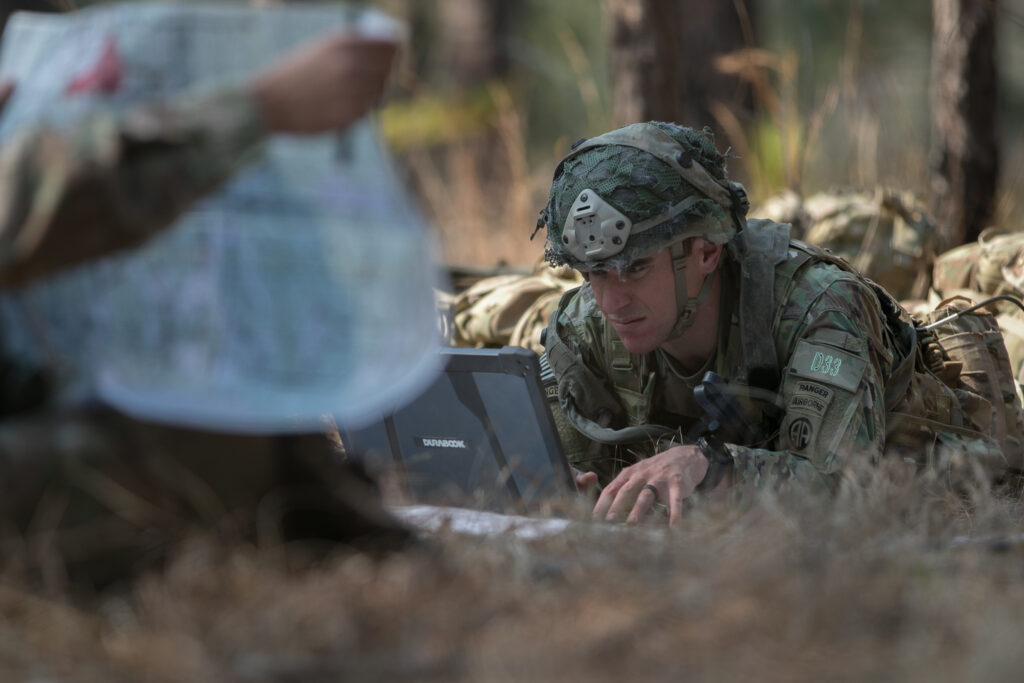
An 82nd Airborne paratrooper checks in on the digital network.
WASHINGTON: The first thing you notice about the Army’s new tactical radios is how much clearer everyone sounds.
“When the network is connected … the clarity of the communication and the clarity of the transmission are better than what I would use to hear via FM,” said Lt. Col. Andy Harris. “When everything is connected and it’s working … it’s very, very good quality. And to me that matters, as a commander, because you need to know what they’re saying.”
But, Harris and Army procurement officials told me, the network upgrade – called Capability Set 21 – has a steep learning curve, which means that troops require both technical training and tactical adaption to get the most out of it.
In fact, when the 1st Brigade of the 82nd Airborne parachuted into the Joint Readiness Training Center at Fort Polk for wargames in March, not every commander felt comfortable bringing the newly issued kit, which they were the first brigade in the Army to get. But the battalion Harris commands, the 1st Battalion of the storied 504th Parachute Infantry Regiment, had extra experience with the new HMS Manpack and Leader radios, having run the program’s official Operational Test back in January.
“We were very, very comfortable with that system,” Harris told me. “The rest of the brigade was not.”

A paratrooper puts together a radio.
Power & Range
One big issue with the new radios? Battery life. The increased capabilities come with increased power draw, and many officer felt they couldn’t burden their paratroopers with weight of backup batteries in the crucial 72 hours after landing.
Army acquisition officials told me they’re already working on battery life improvements, as well as streamlined cabling (the current cables tend to snag on brush), simplified network management software, and more in-depth training in how to use Capability Set 21 to the fullest.
Once you know how to use the network, Harris said, the benefits are dramatic. Not only are voice calls much clearer – a vital consideration when relaying life or death messages on noisy battlefields – they can boast much longer ranges as well.
That can be crucial in combat. For example, when the next wave of reinforcements was delayed three hours, the brigade support battalion commander could call Harris and warn him from Alexandria airport, 45 km (28 miles) away. That wouldn’t have been possible with traditional radios, Harris said. Troops would have had to reply on specialized satellite communications kit and prearranged access to busy SATCOM channels. But the HMS Manpack radio can access the new MUOS constellation, which is much less overtaxed and readily available.
But the HMS radios don’t need a satellite to talk at ranges well beyond what traditional FM is capable of. Traditional analog radio communications are point to point: If radio A is too far from radio B, or if the direct path between them is blocked by hills, tall buildings, or other obstacles, they just can’t talk to one another. But the new digital radios, using the TSM waveform, create what’s called a Mobile Ad Hoc Network (MANET), in which every radio acts as a relay for every other. So while radio A and radio Z might be out of range, or on opposite sides of a mountain, the message will bounce around from A to B to C to D to E, ad infinitum, until it finally find a path to Z.
Even when the connection is too tenuous for a voice call, the HMS radios can still send text messages and automatic data updates, like the real-time position of friendly troops on a digital map. As Harris and his brigade commander moved out in opposite directions, he said, they dropped out of voice communications, but they could still see the locations of each other’s troops and text reports on the progress of their attack. By contrast, sending text and data isn’t an option at all on analog radios.

A communications relay drone, known formally as a Variable Height Antenna.
Data Overload & Dispersion
While the new digital network solves some tactical dilemmas it also creates new ones. For starters, not every soldier needs all that data or can cope with the potential information overload. While Harris’s battalion experimented with giving the digital map to team leaders – junior non-commissioned officers leading three other soldiers – they ultimately decided those young soldiers need to keep their eyes on their gunsights and their surroundings, not on a screen.
“I love the fact that we can pull this PLI [Position-Location Information], but at the team and squad level, they’re in the breach; they’re the ones that are going to close that last 100 meters to win the fight,” Harris told me. “The last thing I want is their face in their [device]. I want them focused on that close-in fighting.”
The other dilemma has to do with how you spread out your troops, Harris told me. To get the maximum range out of a mesh network, you ideally want squads strung out in a line, so each can relay to the next. But that’s a very vulnerable formation, allowing the enemy to concentrate their forces on one squad at a time and overwhelm it. For combat, you want to concentrate your squads at a handful of decisive points – but then the network may not be able to cross the gaps between those points. So commanders must juggle a constant trade-off between dispersing soldiers to relay communications and massing them to fight.
Now, there is a way to extend the network’s range to cover wide gaps without stringing out squads. Officially called the Variable Height Antenna, it’s actually a tethered drone that hovers 200 feet in the air and relays transmissions. During the JRTC wargames, Harris told me, the VHA drones let him talk to another battalion 30 km (19 miles) away.
The problem with the drone, he said, is the bulky communications kit that it requires: four big boxes, each of which requires two men to carry it. So while it is possible to air-drop the VHA with the very first wave of paratroopers, you’d have to dedicate a full nine-man squad to hauling it around instead of fighting. Instead, Harris decided to hold off on bringing in the system for 72 hours, until he controlled an airfield where transport planes could fly in both the VHAs and Humvees to carry them.

A paratrooper uses the digital network to track units’ maneuvers.
Train Up
All told, the new network is much more powerful than old-school FM radio – but it’s also much more complex, so troops need much more training to get the most out of it.
“it’s not the same as the legacy comms when you just grab your [radio], you plug it in, you turn the dial, and you get ready to talk,” he told me. “You’ve got to be training with this capability, you have to – because if you don’t, then you’re going to miss out on some of the great capabilities that it has and you’re just not going to be able to use it effectively.”
That’s not just training communications specialists, Harris emphasized, but regular users and, above all, the unit’s leaders. “I’m talking battalion command teams, brigade command teams, company command teams,” he told me. “Every leader has to understand the capability of this set.”
Army eyes TBI monitoring, wearable tech for soldiers in high-risk billets
“We are also looking at what additional personal protective equipment we can provide to our folks, especially instructors and others who are routinely exposed to blast pressure,” said Army Secretary Christine Wormuth.


























